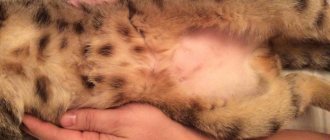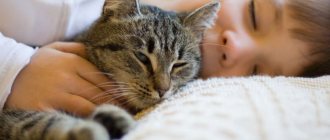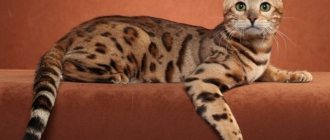Every second home has a cat or male cat, they are loved and cherished. These animals are bought by parents for their children, as well as by single people to stay at home in a cheerful company. How did these animals become so accustomed to people and become so close to us? How did they go through this long process of domestication and become true friends for us?
When did we become friends?
One would think that archaeological evidence would make it easy to understand when cats were domesticated, but wild cats and domesticated cats have remarkably similar skeletons, complicating research. On the island of Cyprus in 1983, archaeologists discovered the jawbone of a cat that was about 8,000 years old. Since it seemed unlikely that humans would have brought wild cats to the island not yet accustomed to humans, the discovery suggests that domestication occurred even earlier.
In 2004, the discovery of an even more ancient site in Cyprus, in which a cat was deliberately buried with a person, made it even more certain that the island's ancient cats were domesticated earlier, pushing domestication back another 1,500 years.
Scientific research
The process of domestication may have begun about 10,000 years ago, when humans settled in the Fertile Crescent, an arched region that includes the eastern shore of the Mediterranean Sea and the land around the Tigris and Euphrates rivers. People stored grain there - the main source of food, which is also loved by rodents, which in turn attracted wild cats. Over time, these wild cats adapted to this artificial environment and got used to people and completely stopped being afraid of them.
Cats were clearly tame around 3,500 years ago in Egypt, where paintings often placed them under chairs. This shows that by that time “the cat had reached the house.” At that time, this animal was a symbol of fertility, since on the frescoes of the ancient Egyptians the cat was depicted under a woman’s chair when the family dreamed of replenishment.
How cats populated Russia. Where did the cat come from?
The results of the latest genetic studies conducted by scientists from a number of countries allow us to take a fresh look at the well-known data on the distribution of the domestic cat across the territory of modern Russia.
The cradle of civilization is a “cat’s cradle” (once again about the concept)
Evidence obtained during archaeological excavations in recent years suggests that the domestication of the cat occurred approximately 9-10,000 years ago in the Middle East in the Fertile Crescent region (an area stretching from modern Turkey to North Africa and from modern Iran to Iraq). during the transition of man to a sedentary lifestyle and with the emergence of agriculture, when small settlements and the first cities began to appear. Kittens for sale Cat nurseries Cat food Atlas of cat breeds
The findings of archaeologists were confirmed by the latest genetic research published in 2007. The results of genetic studies completed by March 2008 confirmed previous findings that all living domestic cats are descendants of the domesticated Middle Eastern wildcat (Felis silvestris lybica), and no other subspecies of Felis silvestris contributed to the formation of the domestic cat Felis silvestris catus as a subspecies. The researchers came to the conclusion that the spread of cats from the ancient center of domestication went along trade routes between ancient civilizations. As a result of these studies, scientists have discovered interesting relationships between individual cat breeds and populations, which can be traced back to human history. Based on the fact that “cats from Turkey had the greatest gene diversity of any other cat,” the scientists concluded that “cats from Turkey were the earliest domesticated,” with particular emphasis on Anatolia. Genetic research continued and new results were published in June 2009. According to the researchers, “over time, wild cats, which were more tolerant of human-dominated environments, began to spread throughout settlements throughout the Fertile Crescent. Selection in this new niche was mainly based on tameness, but the struggle for existence between cats continued to influence their evolution and limited their compliance” in relationships with people…. A key factor in the domestication of the Middle Eastern wildcat (F. s. lybica) was that “people may have even encouraged cats to hang around when they noticed them killing mice and snakes.” The appearance of this subspecies turned out to be no less significant: “large eyes, a truncated muzzle and a high, round forehead” - features that, as is known, evoke in a person a desire to caress a creature with such features and surround it with tender care. Probably driven by these feelings, “some people brought home kittens, simply because they thought they were charming, tamed them, giving cats a place at home.” I think, however, many people are interested in the question of why the Middle Eastern wildcat (F. s. lybica) became the only subspecies of wildcat that was domesticated by humans. The researchers explain this by saying that the Middle Eastern wild cat (F. s. lybica) had an advantage over other subspecies of small wild cats in being the first to be adjacent to the first human settlements. As agriculture spread from the Fertile Crescent, the Near Eastern wildcat (F. s. lybica) filled the same specific niche in each region it entered, thereby closing the door to human habitation for native wildcat populations. An ivory figurine discovered in Israel, some 3,700 years old, confirms that the presence of domestic cats in homes and settlements in the Fertile Crescent was common before they were brought to Egypt. Due to the fact that to date there are no other studies that shed light on the origin of the domestic cat or refute the above-mentioned conclusions, when considering data on the distribution of cats throughout Russia, I will rely on the concept of the Middle Eastern origin of the domestic cat. The main advantage of this concept is the main conclusion that follows from the results of the above-mentioned studies: the domestic cat (Felis silvestris catus), like any other domestic animal, cannot exist separately from humans, who from the very beginning of civilization, migrating across the planet, took everywhere her with you as a faithful assistant, the darling of the family and the keeper of the hearth.
Shorthair cats
A journey of ten thousand years With the development of agriculture and the emergence of surplus food, the population of ancient cities began to increase sharply, which led to the need to colonize new territories. In the 9th-7th millennium BC. e. The settlement of Proto-Indo-Europeans from the Fertile Crescent area increased sharply, which took place on small ships along the banks of rivers, lakes and seas. At the same time, it was established that even then cats swam along with people on sea vessels, protecting ships and food supplies from rodents. This was evidenced by the discovery of the remains of cats on the island of Cyprus, where cats could only arrive on ships along with people, and, therefore, were already domesticated. The colonization of new lands was a constant process that lasted for millennia and was determined both by population growth and the development of agriculture. According to Academician B. A. Rybakov, “from the middle of the 5th millennium BC. e. the settlement of Indo-European farmers in a northern direction is observed.” This settlement is called by some authors “agricultural settlement.” By 3000-2500 BC. e. the north of Europe was almost completely populated by Indo-European tribes, and the need to develop new arable lands pushed the Indo-European colonizers further east. I assume that the appearance of cats on the territory of modern Russia is associated with the appearance of Slavic tribes here in ancient times. As the authors of “History of Russia” write: “The Slavs, according to most historians, separated from the Indo-European community in the middle of the 2nd millennium BC. e. The ancestral home of the early Slavs (Proto-Slavs), according to archaeological data, was the territory to the east of the Germans: from the Oder River in the west to the Carpathian Mountains in the east. A number of researchers believe that the Proto-Slavic language began to take shape later, in the middle of the 1st millennium BC. e." (A. S. Orlov, V. A. Georgiev, N. G. Georgieva, T. A. Sivokhina, “History of Russia”, 2008). The first mentions of the Slavs are found in written sources in the middle of the 6th century. n. e., when Slavic tribes settled across the East European Plain. “During the era of the Great Migration of Peoples (III-VI centuries AD), which coincided with the crisis of slave civilization, the Slavs mastered the territory of Central, Eastern and South-Eastern Europe. They lived in forest and forest-steppe zones, where, as a result of the spread of iron tools, it became possible to conduct a settled agricultural economy" (A. S. Orlov, V. A. Georgiev, N. G. Georgieva, T. A. Sivokhina, "History Russia”, 2008), which determined their way of life and living conditions. In the VI-VIII centuries. In the northern zone of Eastern Europe, the Slavs were dominated by short-lived settlements due to shifting agriculture. The rapid development of arable farming using horses led to the appearance at the end of the 8th century. small villages, and in the 9th century, as ancient Russian chronicles report, ancient cities began to appear in Northern Rus': Izborsk, Ladoga, Novgorod, Polotsk and Smolensk, which, first of all, were places of settlement for merchants and artisans, and also performed defensive functions .. This process continued in the X-XI centuries. with the emergence of such cities as Pskov, Vitebsk, Golotichesk, Drutesk, Logozhesk, Rshu and Yuryev.
' So, the spread of the cat across the East European Plain occurred simultaneously with the spread of the East Slavic tribes. According to the data presented by V. Karpov in his work “Treatise not only about the cat” (yearbook “On Land and Sea”, 1987), during archaeological excavations in the ancient cities of the Northern Black Sea region - Panticapaeum, Tanais, Phanagoria and others, The remains of cats were discovered that date back to the 1st century. BC e.-I century n. e.. V. Karpov writes that these cats were inhabitants of large and rich cities of the Roman Empire. “Archaeologists have not found any traces of cat habitation in rural settlements. The only exception is the find in the Scythian settlement, which is called the Kamensky settlement, but it was the capital of the steppe Scythians on the left bank of the Dnieper, opposite modern Nikopol. In Scythian Naples, the capital of the Crimean Scythians, the remains of cats were not found.” Further, the author writes: “This indicates that the ancient Greeks, trading with the Scythians in gold jewelry, utensils and all kinds of living creatures, at the same time protected the rarest domestic cats for themselves.” However, in the light of new data on the domestication of cats, this is most likely explained by the fact that cats were not needed by the Iranian-speaking Scythian nomads, but by the so-called Scythian plowmen, who, according to some researchers, were a conglomerate of Slavic and Scythian tribes, engaged in shifting agriculture, when they constantly had to move to new arable lands, had not yet led a truly sedentary lifestyle. But let’s continue to quote the author of “Treatise not only about the cat”: “The advancement of the domestic cat from the shores of the Black Sea to the harsh north was slow. Thus, the remains found by archaeologists on the territory of the Kirovograd, Odessa and Cherkasy regions date back to the 2nd-5th centuries of the new era. But again, only one copy in three settlements. However, already in excavations dating back to the 6th-7th centuries, archaeologists recorded the appearance of a cat in Pskov, the Baltic cities and near Yaroslavl. In the 7th-9th centuries, this beast found its way to the region of Staraya Ladoga and the Middle Volga region, and by the 13th century it spread throughout Rus', as evidenced by archaeological finds again. In the Yaroslavl Volga region, archaeologists uncovered more than 600 burial mounds, and 200 contained the remains of sacrificial animals... but cats were found only in two mounds where women were buried.”
From the above, we can conclude that in the 6th-9th centuries, with the advent of the first urban settlements among the Eastern Slavs, cats began to appear in them, which in some certain cases were buried along with their mistresses, while cats were neither sacrificial animals nor food supplies for the feast of their mistresses in the other world. Here I recall the content of an interview with Jean Denis Vigne, vice-president of the Scientific Council of the National Museum of History in Paris, published in April 2004 in the American magazine Science, who reported that in a Neolithic settlement of about village of Shillourokambos (9-7 thousand BC) a burial dating back to 7 thousand BC was discovered. e., with two skeletons: a man and a cat. The sex of the person could not be determined due to damage to the skeleton, but judging by the decoration and the number of objects found, this person played a prominent role in his environment. The cat's burial was located symmetrically to the first. The cat was killed, presumably to be buried with its eventual owner or owner. The heads of both skeletons were directed towards the west, which clearly indicates that cats had a certain, most likely ritual, significance in the life of the ancient inhabitants of Cyprus. In connection with the above, let's try to draw several parallels with the history of the Eastern Slavs. Based on archaeological data, Russian historians have determined that the Eastern Slavs, or, most likely, their ancestors, the Proto-Slavs, treated cats as totem and, possibly, cult animals, and images of cats and other felines served them as amulets. Considering the differences between the cultural and religious traditions of the agricultural era from previous ones, and what connects them and “continues the thousand-year traditions of the hunting society,” this is what Academician of the Russian Academy of Sciences Boris Aleksandrovich Rybakov writes in his fundamental work “The Paganism of the Ancient Slavs”: “An interesting section of zoomorphic plasticity is lids of large vessels. Very often they were designed in the form of heads or even whole figures of animals. The heads of bears, cats or lynxes, deer, goats, figures of a dog and a leopard are known. The preference given to predators is understandable: the lid should protect the supplies placed in the vessel from all possible thieves. The cat will protect you from mice, and the bear will also warn people who encroach on the contents of the storage facility. The simplest magical calculation is evident in these naive measures to protect the farmer’s family values.” Settling throughout Eastern Europe, the Slavs moved mainly along large rivers, which at that time served as almost the only transport arteries for forest and forest-steppe regions. As Professor K.V. Bazilevich writes: “Byzantine writers of the 7th century. they mention Slavic one-tree boats, in the construction of which the Slavs were considered great masters. The high seafaring skill of the Eastern Slavs is evidenced by the fact that Ant Dobrogast was invited by Byzantium to command the Black Sea flotilla. ... Greek sources speak of a great Slavic campaign against Constantinople in 626, and the latest research shows that this campaign was carried out precisely by the Eastern Slavs.” The Tale of Bygone Years also reports on other sea voyages. Under Prince Igor, Russian squads on more than 500 ships sailed the Black, Azov and Caspian Seas, dragging ships from the Don to the Volga and back. The size of the largest ships - rooks - allowed them to accommodate more than 40 people. Therefore, I think we should not exclude the possibility of the presence of cats not only on small ships on which people and household belongings were transported when moving to new lands convenient for arable farming, but also on the fighting boats of the Eastern Slavs. This assumption confirms the guess that cats, which do not accept a nomadic lifestyle, moved with their owners on ships, perceiving the latter as a home, and in the confined space of small-sized ships, domestication processes occurred faster. I will also add that in the burials of the Eastern Slavs of that distant era, it was typical to orient the location of the skeleton with its head to the west. Despite the colossal gap in time separating the burial in Cyprus and the burials on the banks of the Volga, between them there is clearly visible, if not similarity, then continuity of the Proto-Indo-European tradition, and, most likely, in the burial discovered in Cyprus in the 9th-7th millennium BC. e. the skeleton belonged to a woman, as was the case with the two mentioned mounds of the 10th century AD. e., discovered in the Yaroslavl Volga region. There is a green oak near the Lukomorye... It is believed that in the 10th–13th centuries in Russia the cat continued to be a rare “beast”.
At the same time, a vast layer of Russian folklore consists of folk tales, proverbs and beliefs associated with cats and cats. Before the introduction of Christianity in Rus', the Slavs revered pagan gods. The almighty god of the underworld was Veles, the patron saint of livestock, wealth and all animals. Veles’s companion was the Cat, whose name was “Bayun” (otherwise Bai or Bayunok), and many customs and rituals were associated with him. After the introduction of Christianity in Rus', pagan beliefs and rituals were banned. But thanks to oral folklore, the name Kota-Bayun has survived to this day. A lot of fairy tales and beliefs associated with cats and cats, in which echoes of pagan myths are preserved, were recorded by the Russian researcher of folk art, literary and folklore historian Alexander Nikolaevich Afanasyev (1826-1871): “Russian folk tales know the fabulous cat-bayun, who is exactly like this the epithet of the sea is given, like other personifications of rain clouds, and which legends place in close connection with the wonderful mill - the emblem of the thunderous roar. Near this mill there is a golden pillar, a golden cage hangs on it, and a bajun cat walks along the pillar: it goes down - it sings songs, it goes up - it tells fairy tales... The voice of the Bayun cat can be heard for several miles; His power is enormous: he strikes his enemies to death or with his songs sends an irresistible sleep over them... Whoever kills a cat, according to the peasants, will have no luck in anything for seven years.” Even the good spirit-protector of the hearth - the brownie - turned into a cat when he wanted to warn the owners of danger and ward off trouble. Until now, in our everyday speech we often repeat the name Kota-Bayun, since many words of the modern Russian language are derived from it: “fairy tale” - fairy tale, “krasnobay” - talker, “pribautka” - joke, “cradle” - rock a child to a lullaby. All this, in my opinion, is indirect evidence that cats were not only well known in Ancient Rus', but were also widespread. The earliest written mention of a cat dates back to 1230, when the Novgorod chronicles talk about a famine during which they ate carrion, horse meat, dog meat and cat meat. Of great interest are the finds made in Old Ryazan, where during archaeological excavations in a layer dating back to the period of the conquest of Ryazan by Batu in 1237, the remains of 7 cats were found, and in the home of a bone carver, a bone plate for binding a handwritten book, carved in in the form of a stylized image of a cat. The next interesting discovery was made during excavations of the historical layer from the time of a strong fire, which occurred during the capture of Kiev in 1240 by the Tatar-Mongols led by Batu (aka Batu Khan), when the remains of a girl with a key were discovered on the threshold of a barn with a cat locked inside . One can imagine this eloquent episode of a great tragedy, when a child rushed to save his pet, a cat, but a burning beam fell, crushed the girl and they both died in the flames of the fire. Zarine Lorentsovna Arushanyan
Read part 2. How cats populated Russia.
European Shorthair or Celtic? Cats
History of the origin and distribution of cats
How cats populated Russia. Where did the cat come from?
Ancient DNA of cats
A comprehensive study of cat genes shows that even after felines came into our lives, they remained largely unchanged for thousands of years. In a new comprehensive study of the distribution of domesticated cats, DNA analysis reveals that cats lived for thousands of years alongside humans before being domesticated. During this time, their genes have changed little compared to those of wild cats, with the exception of one recent change: the characteristic stripes and spots on their fur.
According to scientists' research, we can know that the earlier ancestors of modern domestic cats spread from southwest Asia and into Europe as early as 4400 BC. Cats likely began hanging around farming communities in the Fertile Crescent about 8,000 years ago, where they established a mutually beneficial relationship as a rodent patrol for humans.
All about domestic cats
If a cat lover is thinking about getting a cat, he or she might be interested in knowing how many breeds there are and which one is best suited. When people think of cats, five or six breeds come to mind, but there are more than 50 varieties of domestic cats, classified according to the animal's different characteristics.
Colors
Serval (domestic cat): size and weight of the African breed
Cats have beautiful coats inherited from their wild ancestors. And it is this evolution and its combination with genetics that has led to the variety of colors and patterns seen in different breeds today.
Note! The color and shade of an animal depend mainly on melanin and its two components: eumelanin and pheomelanin. It is the combination of both that, to a greater or lesser extent, determines the color of the animal. Eumelanin produces brown and black colors, while pheomelanin produces red and yellow.
A cat is a species of animal that can have a variety of colors
Features of behavior
Before adopting a cat, it is advisable to know that although cats are one of the most common pets around the world, they have their own characteristics, habits and temperament that you need to know.
System of signs and self-expression in behavior
The cat is an independent and curious nocturnal animal with amazing physical capabilities like the lynx. Thanks to her body's characteristics, she is capable of performing countless pirouettes and jumps almost anywhere. But without a doubt, the main characteristic of these small animals is their personality. The cat wants to have its own space, even outside. We should not forget that a domestic cat is an independent creature, very different from dogs.
Relationships with other animals
Felines are also solitary animals, and in addition to independence, they need privacy. They generally do not like to share their territory with other individuals, be it other cats, dogs or people. The more cats there are in the house, the worse the situation can become.
Note! Living with other pets can cause a lot of stress for the animal, increasing the likelihood of health or behavioral problems.
Relationships with a person
One of the most outstanding characteristics of felines is that they are independent above all else. They are also affectionate and skilled predators. But you need to keep in mind that, like all animals, cats have different temperaments. For example, even the most affectionate cat can bite a child’s hand or hit him with his paw out of play.
For your information! The interpersonal relationship between an animal and its owner creates a sense of well-being and reduces stress by causing the release of oxytocin, also known as the “love hormone.”
Mating and reproduction
Sexual maturity in the female occurs in 4-5 months.
Fertilization rarely occurs on the first try. Animals give birth in litters from 1 to 10 kittens. After a gestation period of about two months, the newborns will accompany the kitty.
Maternal instinct lasts only 2 months, after which the cat begins to ask for a cat
Spots and stripes on fur
Wild and domestic cats had no significant differences in their genetic structure, and one of the few traits available to differentiate them was their coat markings.
The study sheds light on the late appearance of spotted or tabby coats, which began appearing in domestic solid-colored cats in the Middle Ages. The gene for the striped coat dates back to the Ottoman Empire in Southwest Asia and later became common in Europe and Africa.
However, it was not until the 18th century that markings became common enough to be associated with domestic cats, and in the 19th century, cat fanciers began selecting cats with special traits to create unusual breeds.










